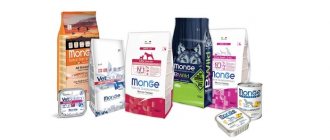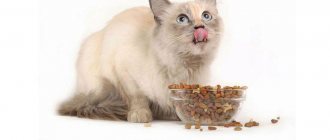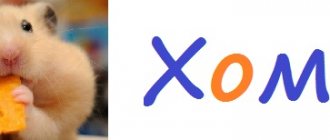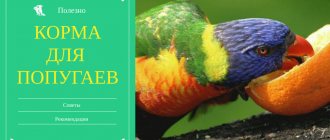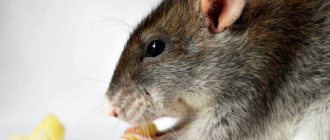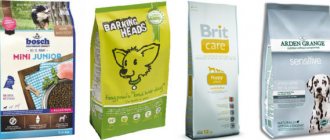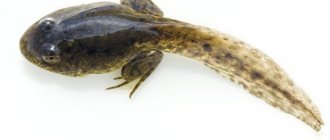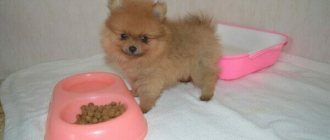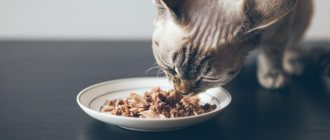We are sure you already know how cute hamsters are and how important what we tell you is. Therefore, let’s do without the “classic” useless introduction, let’s get straight to the point.
Let's start with what to feed a hamster at home and, without wasting time, move on to the list of prohibited items.
Feed me right!
What can you feed your hamster?
Rodents have a weak stomach, so you should only feed them foods that they can digest. Like many other animals, hamsters should not be given table food, herbs, hot and sour vegetables. So what does a hamster eat at home?
Grain mixtures
A ready-made mixture can be purchased at a pet store. Grain mixtures are the main food. They are quite balanced, contain a full range of nutrients and are intended for daily feeding.
When purchasing a ready-made mixture, you need to check the expiration date and the tightness of the packaging. Before you feed grains to your hamster, you need to make sure of their quality. It is necessary to pour some of the beans from the package into the palm of your hand and inspect. The surface of the grain should be smooth, even, and have a glossy surface. There should be no mold or musty smell.
Important! The grain mixture should be intended for rodents only. You cannot buy mixtures, for example, for parrots.
You can also buy the grains separately, mix them and feed them to your hamster.
The composition of grain feed includes:
- Wheat;
- Oats;
- Millet;
- Linen;
- Barley;
- Flax seed;
- Sunflower seeds;
- Pumpkin seeds;
- Chumiza;
- Milk thistle;
- Nuts;
- Lentils;
- Chumiza;
- Corn;
- Sudanese;
- Legumes;
- Buckwheat;
- Pumpkin seeds.
When feeding with grain mixtures, the need for vitamins and minerals is fully satisfied. Cereals contain vitamins A1, B1, B2, C, iodine, magnesium, calcium.
Vegetables and fruits
Vegetables and fruits must be present in a hamster's diet. Vegetables contain a lot of fiber and improve the functioning of the digestive system. Fruits are a source of vitamins and should also be included in the rodent’s diet. Vegetables and fruits can be fed to your hamster either raw or dried.
What vegetables can you give your hamster:
- Carrot;
- Cucumber;
- Bell pepper;
- Pumpkin;
- Zucchini;
- Radish;
- Beet;
- Eggplant;
- Broccoli;
- Cauliflower;
- Tomato.
What fruits can you give your hamster:
- Apples;
- Pears;
- Banana;
- Peaches;
- Nectarines;
- Plums;
- Apricots;
- Melon watermelon.
It is better to give melon and watermelon at the height of the season, since in the earlier period the fruits can contain large amounts of nitrates. Feed your hamster rarely and in small quantities, since watermelon and melon contain a large amount of water and can cause diarrhea.
Tree branches
When keeping a hamster at home, you must include solid food in the menu. A hamster's teeth grow throughout its life. By gnawing tree branches, the hamster wears down its teeth.
Before offering branches to your hamster, they must first be prepared. It is important that you need to collect branches away from the road, preferably in the depths of the forest or in a garden plot. The branches must be thoroughly washed and then scalded with boiling water. This kills all bacteria and infections.
What branches can be fed to home:
- Apple trees;
- Pears;
- Maple;
- Birches.
Water
Water should always be freely available in the cage. Check the water bowl daily. If there is contamination in the water, it is necessary to rinse the drinking bowl and pour clean water.
For your hamster you need to use clean filtered water. Do not pour water from the tap. You can use bottled or boiled water.
What else can you feed your hamster?
Depending on the type of hamster, the diet should be different. Also, when feeding a rodent, it is worth taking into account its individual characteristics and predisposition to diabetes.
Protein food Domestic hamsters do not hibernate. But still, during this period they need to increase the amount of protein food up to 2-3 times a week. It is also important to add protein to the rodent's menu during pregnancy.
Protein food menu:
- Boiled chicken;
- Eggs;
- Boiled fish of non-fatty varieties;
- Shrimps;
- Gammarus;
- Mealworms.
Greenery
Among the greens, hamsters like to eat clover leaves, nettles, dandelion leaves, and plantain.
You can pick dill and lettuce in your garden plot.
In winter, you can sprout wheat and oats on the windowsill and feed the sprouts to your hamster.
Sprouted grains
Sprouted grains are an excellent nutritious food for rodents. Some of the grains can be sprouted and fed to the hamster, the other part can be left and the sprouts can be fed.
Nuts
Nuts contain a large amount of fat. Therefore, they feed the hamster in small quantities and not often.
Nuts you can give your hamster include peanuts, hazelnuts, walnuts, and pine nuts. You can also use sunflower, pumpkin, and melon seeds.
Porridge
Porridge can be periodically added to the hamster's menu. It is important that the porridge must be cooked in water without sugar, salt or other additives.
You can feed buckwheat, rice, corn, and rolled oats porridge.
Dairy
Dairy products must be low in fat.
Berries
Berries can be given either fresh or frozen. You can also feed dried berries.
The hamster can eat strawberries, wild strawberries, gooseberries, cherries, currants, cherries, and blueberries.
Large seeds from berries must be removed, since they contain hydrocyanic acid, which is dangerous for animals.
When to feed your hamster
Hamsters are nocturnal animals, so you need to feed them in the evening. In the morning, you can offer a small amount of low-calorie food, such as fruits or vegetables.
Hamsters are prone to obesity and diabetes. This greatly reduces the animal's lifespan. Therefore, watch the quantity and quality of food. Everything that the hamster does not eat here and now, the thrifty rodent will definitely take to his pantry.
The rodent's pantry must be emptied periodically. To prevent your pet from getting upset, offer him some kind of treat in return. If food supplies are not removed from the cage, over time they will begin to deteriorate and rot.
Not only the pet’s health and activity, but also its life expectancy depends on proper and balanced nutrition. It is also important to monitor the quality of food and not to overfeed the hamster.
This is interesting: Where does the Andean bear live? Range, map and habitat
In what form should hamsters be given plant food?
Of course, it is best to feed your hamster fresh vegetables and fruits, because during heat treatment food loses some of its vitamin substances. Consequently, food becomes less healthy. Sometimes vegetables and fruits can be boiled for a rodent, but for a minimum amount of time. It is strictly forbidden to add salt to the water.
Veterinarians attach great importance to the freshness of products and the degree of ripeness of fruits and vegetables. Some hamster owners are interested in whether it is possible to give their pets slightly weathered foods. The answer is negative. In stale fruits, putrefactive processes begin, caused by the proliferation of bacteria and fungi. Such food can cause serious poisoning of fluffies. If, for example, you find a small gray speck on a plum, you should not cut it off and give the fruit to the hamster. After all, the stain itself is already the organs of mold reproduction, which means that the entire plum is already infected with the fungus. When eating a stale treat, the animal will inevitably develop diarrhea.
Another important question: can hamsters eat unwashed vegetables? And again the answer is no. Even if you grew a cucumber or zucchini on your own plot, there may be pathogenic bacteria and sometimes even helminth eggs on their surface. Therefore, be sure to wash the fruits before giving your hamster a treat.
Dried fruits can be given to hamsters, but in very small quantities. Such restrictions are due to the high sugar content. If you have a Syrian hamster, you can feed it with half a prune or dried apricot a couple of times a week. But it is better to offer the Djungarian hamster banana chips or dried apples, they contain much less sugar. When taming or training a pet, it is allowed to feed it with small pieces of dried fruit (the size of a sunflower seed).
How much do hamsters eat?
Many people take hamsters as pets because they are cute "cheek stuffers." The problem is that they quickly gain fat and this shortens the life of the rodent. Therefore, please read the feeding recommendations below carefully.
Measure portions correctly!
The hamster is a nocturnal animal. In the evening he has “breakfast”, which should be the main meal of the day. Many people give food to their pet only in the evening, and there is no mistake in this, but it can be divided into 2 times (give the smaller portion in the morning).
It’s difficult to say how much food a hamster needs every day, it depends on:
- Hamster breeds
- Sizes
- Health conditions
- Amount of physical activity
Syrian breed
The most common and no less intriguing type. Easy to train. Maintenance is not difficult. It has four toes on the front toes and 5 on the back. The largest of all types of domestic hamsters. Mainly has a golden color. An adult reaches a length of twelve centimeters. The body is plump like everyone else. In everyday life, animals often reach twenty centimeters. Males weigh one hundred twenty grams, and females one hundred and forty. Individuals twenty centimeters in length reach a weight of two hundred grams.
When leaving, the main factor is peace of mind. Under no circumstances should you take your pet out of its cage when there are many people in the room. The noise scares him, he begins to get nervous, and may bite or get sick.
Has the hamster already said “thank you” to you?
Knowledge without practice is useless ballast. Right now, tell your family to stop stuffing food into the poor animal all day long. And if your hamster learns to talk, the first thing he will say to you is: “Thank you very much!”
Come back! I'll miss ?
Various goodies
Grocery stores offer a variety of treats for hamsters. But before purchasing such food, you should make sure that there is no salt, sugar, flavor enhancers or flavorings in their composition. Such additives are a slow poison for rodents. Therefore, it is better to give preference to the following foods:
- Nuts.
- Banana chips.
- Dried fruits and dried vegetables.
- Sunflower seeds.
Sunflower seeds are a treat for your pet hamster.
Nutrition of sick, weakened and elderly animals
As a hamster ages, its teeth begin to deteriorate, and therefore it eats much less actively. Therefore, the diet of such an animal should be dominated by pureed vegetables, ground nuts and food. It is also possible to use baby porridge without milk. But in order to avoid intestinal upset, one should not give up grain feed, which should still be the main one in the rodent’s menu.
In addition, porridge can be used to add vitamins and medicines to support and treat weakened and sick animals. However, a jar of such food cannot be stored in the refrigerator for more than two days.
Warm brewed chamomile is often used to drink sick children. It should be prepared twice a day. But giving honey or milk to a sick animal is strictly prohibited . If the animal does not want to eat, it must be force-fed. Without food he will not be able to get better. In addition, prolonged starvation can lead to the death of the rodent.
For feeding in case of illness, syringes without a needle are often used. In this case, the owner should hold the pet at an angle in one hand and a syringe in the other. In this situation, porridge for small children would be perfect. You can also grind the food and mix it with water. When feeding weakened or sick animals, it is important to be extremely careful so that they do not choke on food or water.
Canned food
Canned food cannot be fed to domestic rodents, because they contain harmful sugar, salt, hot vinegar and spices. In addition, some preparations are very fatty (vegetable caviar, winter salads).
Under no circumstances feed your furry friend canned and fried vegetables, jams and compote berries. At best, such food will upset digestion, at worst, it will provoke a stomach ulcer or the appearance of tumors.
Fresh fruits will help strengthen the hamster’s body, preserve its eyesight and the beauty of its fur. However, a balance in nutrition should be strictly observed: vegetables should be given along with animal food and dry food, and not instead of them. It is important to keep food fresh and wash it before putting it in your hamster's bowl.
How and what do rodents drink?
If there is a large amount of fresh, juicy vegetables, fruits and herbs in the diet, the homa may drink very little or not drink at all. For example, cucumbers are 90% water. However, there should always be fresh water in the cage. The water in the drinking bowl should be changed at least once a day. If debris from the cage gets into the water bowl, the water must be changed immediately so that the animal does not get poisoned. There are several types of special closed drinkers on sale that prevent tipping over and contamination of the water in the container.
This is interesting: How much do penguins weigh?
Types of feed
JR Farm
The first most popular food for small pets. It is unique in composition, as it contains a lot of the most beneficial vitamins and minerals, which greatly helps the digestive process. This manufacturer has collected the most delicious ingredients, which include red millet and wheat ears. The product contains a huge amount of protein, which makes the product the most popular.
Despite the large number of advantages, the only disadvantage is the inconvenient packaging. The general public opinion about this product is positive, which allows it to occupy the top line of the rating.
Benelux Special
The next food I would like to talk about. This is a product of one of the most popular premium brands. Its composition is unique because it includes the best components that should be given to a small pet. There are also enough useful minerals and substances that contribute to the full life of your pet. In addition to the advantages, the disadvantages of the product can be noted - it is relatively high cost and low protein content. But this product also received popular love.
Fiory Criceti
The first among foods to support immunity. The composition of this product is varied - it includes different types of cereals, peanuts, peas, honey. A large amount of vitamins, amino acids, and minerals also predominate. All this is perfectly absorbed by the body of a small rodent and supports the immune system.
The disadvantages include the limited amount of protein and the presence of honey, which is not indicated for all animals, as it can cause an allergic reaction.
Padovan Grandmix Criceti
The list of permitted foods includes fruits, vegetables and herbs. For example, you can add dried fruits to your Djungarian hamster's diet. In the first place, the basis of the diet still remains food made from durum wheat and grain. In order for the hamster's teeth to be ground down, it is produced in granules.
What fruits can pets eat?
Fruits that hamsters eat at home should be fresh and ripe, but without rot. It is better if it is local and seasonal fruits. Citrus and various tropical fruits should not be given. The bones must be pulled out so that the baby does not choke. Sour fruits are contraindicated.
If you are training a baby or teaching him, for example, to use a running wheel, you need to stock up on “goodies.” Sunflower seeds or cookies are suitable for this purpose. Sometimes you can feed your baby a banana. But since rodents constantly need to wear down their teeth, they must eat more solid food. In addition, bananas contain a lot of sugar.
Repeat “fruit” days no more than 1-2 times a week.
Hamster's daily diet
When choosing what to feed your pet, try to ensure that the food is varied, balanced in composition, and contains vitamins.
| You can give | Not recommended | Forbidden |
| Dry food mixtures for hamsters | Food for other animals or birds | |
| Cereals | Rice (can be given only for diarrhea, well boiled beforehand) | Pasta |
| Vegetables (raw or cooked) | Potatoes, cabbage, onions, garlic | |
| Fruits | Watermelons | Citrus fruits, kiwi, mango, persimmon, pineapple |
| Greens: parsley, dill, lettuce, clover, young nettle | Sorrel, lawn grass, strong-smelling herbs and spices | |
| Sunflower, melon, pumpkin seeds | Watermelon seeds | |
| Nuts | Almonds, acorns, apricot and cherry pits | |
| Wheat sprouts, oats, alfalfa | Bread (black and white), muesli, drops for animals | |
| Legumes | Red beans | |
| Homemade dried fruits | Store-bought dried fruits | |
| Leaves and branches of deciduous and fruit trees | Needles, branches of coniferous trees |
Animal protein is necessary for complete nutrition of a rodent. It is found in the following products:
| Can | It is forbidden |
| Boiled lean chicken meat (breast) | Boiled and smoked sausages, frankfurters, sausages, lard, ham, etc. |
| Yogurt and low-fat cottage cheese (1% fat) | Cheese, sour cream, homemade cow and goat milk, butter |
| Chicken and quail eggs | Honey, ice cream, mushrooms, fruit juices |
| Boiled lean fish | |
| Grasshoppers, butterflies, mealworms purchased at a pet store | Earthworms and other worms from a flower bed or summer cottage |
| Gammarus (dry crustaceans), also sold in stores |
Do not overfeed the animal, do not put more food in the feeder than the prescribed amount. Otherwise, your pet will quickly gain excess weight. Better buy him toys and a running wheel so that he moves more and does not suffer from obesity.
If you liked the article, leave a review. Write to us what else you would like to know about your little pets.
Vitamins for hamsters
Despite the fact that modern food for such rodents, sold in pet stores, is created taking into account their need for vitamins and microelements, sometimes they require additional amounts of nutrients. This will help pets not get sick from dangerous infectious or viral diseases. Often such additives must be present in the animal’s daily diet.
Nowadays there are many vitamin tablets for hamsters on sale. There are whole useful complexes for rodents. Such supplements are not only beneficial for their health, but also allow them to sharpen their teeth. Therefore, pets can stop gnawing on the cage and various objects available to them.
Despite the fact that mineralized or vitamin mixtures are sold today in different types and different compositions, their selection should not be carried out by the seller or owner, but strictly by a veterinarian. Only he is able to prescribe the optimal complementary feeding and its dosage, based on the age and physical condition of the animal, as well as the characteristics of its diet and lifestyle.
Modern experts agree that you need to feed your hamster five times a day. At the same time, he needs to be given so much food that he does not leave anything in his feeder. Therefore, portions should not be very large.
Since many owners now have little idea of the proper feeding of hamsters, and there are not very many decent materials on this topic, in all doubtful cases or if problems with the pet’s health arise, it is worth consulting an experienced veterinarian.
What I am a master at is talking incessantly about hamsters. I have three hamsters at home, and my husband has a pet rat. That’s how we live, the six of us eat, the six of us sleep :)
Post Views: 5,548
Vegetables
Vegetables are very healthy by nature, they have a lot of vitamins and fiber. But not everyone is suitable for the diet. Some can cause negative reactions in the body or even provoke an allergic reaction. Therefore, when creating a menu, be extremely careful.
Every day you can give:
- Carrots and peppers. They contain microelements that will greatly help in the prevention of age-related diseases. The high acid content will help weakened immunity.
- Peas and beans. They will give the hamster huge reserves of protein with vitamin B. They improve metabolism. Lots of other vitamins and minerals.
- Squash and cucumbers. They will restore the amount of fluid in the body, the peel will provide vitamins and microelements.
There should also be other vegetables on the menu, but there is no need to overdo it so as not to harm your pet. Pumpkin products can be given very rarely due to the higher amount of sugar.
What is it strictly forbidden to feed?
Regular cabbage or its stalk can cause diarrhea. Horseradish will consume a lot of water. If you include heads of garlic and onions in your menu, the chance of allergies will increase. Regular potatoes cause stomach problems, but they can be given boiled. When feeding, you need to chop everything very finely. Store in a cage for a maximum of six hours.
List of prohibited products
What is strictly forbidden to feed a hamster:
- spicy, salty, smoked and canned foods;
- any spices;
- citrus and exotic fruits (lemons, oranges, tangerines, grapefruits, avocados, etc.);
- onion garlic;
- cabbage;
- potato;
- watermelon;
- mushrooms;
- sweets.
The list of prohibited herbs includes cereal leaves and dandelion. The sharp serrations on these leaves can injure your hamster's cheeks. Dandelion should not be given because of the milky juice.
How to prepare food?
Everything should be of the first freshness. Cook the food for up to ten minutes. Salt is prohibited; hamsters are not allowed spices. Everything should be fresh. If food is stale, it should not be given under any circumstances. In such supplies, tissue begins to rot and bacteria multiply. You may be poisoning your hamsters without knowing it. Moreover, you should not cut off part of the moldy fruit and give the rest to the animal. In the best case scenario, your pet will end up with diarrhea. You can offer only washed products.
Article on the topic: Rating of the best food for hamsters (Djungarian and Syrian)
Nutrition and care: dangers of improper feeding
It happens that inexperienced pet owners feed their animal seemingly correctly, but get poor results: the animal gains excess weight and digestive problems arise. What could be the reasons:
- the animal is given a lot of treats;
- The animal does not have enough “simulators” at home;
- hamsters' diet consists mainly of ready-made meals: cereals and boiled vegetables
It is unacceptable to feed hamsters this way, even if they like it.
In nature, animals run up to several kilometers a day. They need exercise. In addition to the wheel, for running the cage must have: paths, labyrinths, passages and ladders.
The hamster eats twice a day: morning and evening. The evening portion should be larger, since evening is the peak activity of these nocturnal animals. There is no need to impose restrictions on dry food so as not to create additional stress for the animal. Let the dry mixture remain in the feeder at all times. Change it so that it does not have time to deteriorate. But treats – dose them, especially if they are sweet, if you don’t want to fatten the animal and make it sick.
What do little hamsters eat?
If everything is fine with the mother, the cubs usually do not need additional food. But if for some reason the babies are left without a mother or she refuses to feed them, you will have to feed the babies using a pipette or a painting brush. Buy a special formula for newborns at a pet store and dilute it to the consistency of milk. Newborn babies should be fed every two hours, then gently massage their tummies to improve digestion. Small hamsters need to be provided with a bottle of warm water (not higher than +31 °C).
At the age of two weeks, you can already give baby formula (Gerber, Agusha), thin porridge with water and without sugar, crushed cottage cheese, egg yolks and fresh herbs.
From three weeks you can give pureed “adult” food. As a rule, at this age babies can already eat on their own.
Pregnant and lactating hamsters need more protein foods.
What do dwarf hamsters eat?
Feeding Djungarians is practically no different from feeding Syrian hamsters, with one exception. Children are susceptible to diabetes. For this reason, hamsters should not be given sweet fruits as their main diet. It is better to limit yourself to rare cases and give such fruits in small quantities.
Rules for feeding at home
In the wild, the daily menu of hamsters is determined by their habitat. To ensure that your pet does not experience a shortage of essential food in captivity, you need to carefully think through the diet and maintain a balanced level of macro- and microelements in the animal’s body.
Mode
Veterinarians recommend feeding your hamster 2 times a day - morning and evening. It is better to give fresh food first so that the rodent does not start hiding it in the pantry. The bulk of the food is served in the evening. Hamsters are crepuscular rodents that prefer a nocturnal lifestyle.
To prevent your pet from overeating or experiencing food shortages, you need to adhere to the established feeding regimen.
Quantity
Depending on the age and size of the pet, different amounts of food are required. The hamster consumes quite a lot of food, and the daily norm is 80-100% of body weight. Appetite is determined by breed characteristics, microclimate and individual preferences of the individual.
The hamster considers food not only as part of the daily menu, but also as a strategic reserve. Therefore, uneaten food is put aside by the rodent in case of starvation. This leads to the appearance of an unpleasant odor and the development of pathogenic organisms in spoiled products. To prevent such troubles, you should remove the remains in a timely manner. Instead, you can put a few seeds in your pet's storage.
Fruits and berries
Fruits and fresh berries are very popular with domestic rodents. But is it possible to give them to rodents, because they are very sweet? In fact, rodents even need to be fed fruits and berries, but in reasonable quantities.
In this matter, the breed of the animal is of great importance. For example, Syrian hamsters can be periodically offered sweets, but dwarf hamsters need just a little bit of them: not as food, but as a reward. The fact is that representatives of the Dzungarian breed are susceptible to diabetes, which can be triggered by excessive consumption of dried fruits, fresh fruits and berries.
We invite you to figure out which fruits can be given to hamsters and which ones are not advisable to give. Firstly, you should not feed your animals citrus fruits and exotic fruits, because unusual food can cause an allergic reaction in a hamster, including anaphylactic shock. The pet may even die! Secondly, you should not give homea fruits with seeds: he can break his incisors on them, injure his cheek pouches with sharp edges, or even get poisoned by eating the core of the seed.
Here is a list of allowed fruits:
- Pears, apples. Rich in vitamins C and E, calcium, silicon, phosphorus, magnesium, iron. These substances support the animal’s immunity, strengthen teeth and bones. Pregnant hamsters are especially recommended to eat unsweetened apples. Pets can eat apples and pears both fresh and dried.
- Apricot and plum. The composition includes B vitamins, ascorbic acid, a large number of carotenoids, and microelements. It is better to treat your pet with slightly unripe apricots; you should not feed overripe fruits. Is it possible to give a hamster a peach, since it is a relative of the apricot? It’s better not to, because peach has much more sugar.
- Banana. Contains all possible vitamins except cobalamin, calciferol and biotin. The healthiest fruit should be presented as a treat. Since there is not much sugar in a banana, you can pamper your pet every day. It is allowed to treat your hamster with banana chips every day (in small quantities, of course).
- Watermelon and melon. The fruits are very sweet and juicy, so you should offer them to your pet no more than once a week.
Some berries will also be useful for rodents. Their list includes grapes (including dried), fresh raspberries, cherries, strawberries and blueberries.
Grapes are a very juicy berry; they contain biotin, alpha-tocopherol, B vitamins and many useful microelements (potassium, iodine, cobalt, silicon, etc.). These substances have a positive effect on the appearance of the coat, the health of the heart and blood vessels of rodents. Dried grapes (raisins) have a high content of iron, phosphorus, calcium and potassium - these elements must be present in the diet of pregnant females. However, you shouldn’t get carried away with grapes: Syrian hamsters can be given 3 raisins a week, while one will be enough for Djungarian hamsters.
Raspberries contain carotenoids, vitamins C, H, E and a wide range of microelements. Hamsters are given raspberries to prevent vitamin deficiencies and generally strengthen the immune system. But often you should not feed your hamster this berry, so as not to provoke diarrhea.
Cherries and sweet cherries. Juicy drupes contain a variety of vitamins and minerals, and the peel contains a lot of fiber. You can feed your fluffy with them after removing the bone.
Strawberries and blueberries are a rich source of ascorbic acid, which strengthens the immune system, helps resist viral infections and premature aging of the hamster.
Why are cookies harmful?
Hamsters have a very low tolerance for sweets, salty and fatty foods. Especially harmful for Djungarian hamsters, which are predisposed to diabetes. You can occasionally offer your hamster dry, unsalted biscuits. But we are not immune from the fact that even such store-bought cookies contain a lot of harmful additives and chemicals. They have a detrimental effect on the liver and digestive tract of the rodent. Salt, which is very high in crackers, damages the heart and kidneys. As a result, the immune system weakens and other vital systems suffer. A hamster with a cookie looks very cute, crunches funny, and crumbs remain on its antennae. But you shouldn’t risk your pet’s health to admire this picture; it’s better to choose a healthy alternative to the treat.
Choosing a variety
Which variety to choose for dzungaria and do you need to process the fruits? There is no need to choose varieties that are too sweet; your pet will like them, but they can be harmful to health. Too sour fruits are also not suitable; ripe, moderate-tasting fruits are best. If you choose a fruit that is not ripe enough, the animal may have digestive problems.
Regarding processing, the rules are:
- Store-bought apples must be peeled; the fruits may be treated with chemicals. This condition especially applies to fruits purchased in winter. In cold weather, it is better not to buy them for your pet.
- Homemade fruits must be washed.
- Dried apples are better for winter. Soak them in water before giving them to your hamster.
- Fruits must be washed thoroughly under running water.
What foods should not be given to hamsters?
Spices: pepper, salt, cinnamon, vinegar - everything that we use as a food additive. That is why it is extremely undesirable to feed a hamster from a human table.
Fatty foods (sausages, fatty meats, cheeses, milk, lard, butter, heavy cream and sour cream), sweet foods (honey, sugar, jam, sweets), salty foods (canned vegetables, salted fish, etc.) are harmful to a hamster. , flour (bread, especially white, buns, cakes, pastries), spicy (dishes with pepper).
Fruit seeds are harmful and may even be toxic: peach, apricot, plum, cherry seeds. You should not give hamsters spruce, pine cones, or nuts in shells. With sharp edges, hamsters can damage their cheek pouches, and fruit tree seeds can cause poisoning.
It is not advisable to give your hamster spikelets with grains: the sharp edges of the spikelet can also prick the cheek pouches.
But maybe it’s still possible, if you’re careful
The hamster is a very curious animal and puts almost everything into its mouth. The teeth need to be ground down with something. So, if a pomegranate seed falls into his paws, he will eat it without hesitation. But, as we have already said, not everything that is useful for people is also useful for hamsters.
But it’s delicious... is it really impossible? Even a grain?
Yes, pomegranate is the king of fruits. We will modestly keep silent about Thai durian, where can you find it here? By the way, I wonder if a hamster can have durian?
Stop. We got distracted. Let's continue. The problem with pomegranate is that it is very rich in all kinds of vitamins and microelements. It is in them that its danger for the hamster lies.
For reference: pomegranate contains about 15 amino acids, five of which are essential for the body. Also, it is rich in vitamins K, C, B9 and B6 and minerals (potassium, copper, phosphorus). With all this richness, it is a low-calorie fruit. There are only 72 kilocalories in 100 grams.
So why is it so harmful to our furry pets:
- Tannins found in the fetal crust slow down the peristalsis of the intestinal tract, which leads to constipation. Considering the size of the animal and its rapid metabolism, this constipation could cost him his life. Also, the peel of the fruit contains some alkaloids, which can simply kill the poor fellow.
- The fat contained in pomegranate seeds puts a lot of stress on the liver.
- A high content of vitamins will lead to hypervitaminosis (to put it simply - too much), which is also not good for poor Khoma.
- Too much acidity in pomegranate juice is bad for the digestive system.
- Don't forget about common allergies. In the wild, hamsters are unlikely to eat pomegranate, so there is no immunity to new substances in the animal’s body. If you see that your pet is often itching, his eyes are red and tears are flowing, then most likely the poor thing is suffering from allergies or poisoning. Urgently remember what you fed and try not to give this food again.
Yes, pomegranate is a wildly useful thing, but not for hamsters.
Interesting fact: Syrian hamsters are less susceptible to pomegranate, since they still have a chance to try it in the wild. But it’s still not worth giving a Syrian a pomegranate on purpose. It’s better not to even show it to the Djungarians at all.
What are the benefits of cherries?
Is it possible to give this berry to rodents? Definitely yes. After all, it contains large quantities of useful substances necessary for his body. Vitamin C, which is present in abundance in berries, strengthens the immune system and increases the body's resistance to colds and infectious diseases. Accelerates the healing process of wounds, regulates the process of hematopoiesis. The berry has a positive effect on kidney function, acts as a diuretic, and removes excess fluid from the body. If your hamster suffers from cystitis, pyelonephritis or other urinary tract diseases, including this product in the diet will be very beneficial for him. It has a beneficial effect on the gastrointestinal tract, kills pathogenic microbes, improves metabolism, and stimulates gastric motility. Acts as a laxative for constipation. Promotes rapid bowel movement and removes toxins. Berries should be given to hamsters with various bone diseases (arthritis, arthrosis), because they contain carotene, which helps strengthen bones, teeth, and the nervous system. It also acts as a natural pain reliever.
Is it possible to give this treat if you have dysbacteriosis? Berry juice has a beneficial effect on intestinal microflora, relieves pain and inflammation. It has antibacterial properties and stops the putrefactive process in the body.
In small quantities, the product is very useful for hamsters of the third and fourth year of life, because the berry promotes the secretion of gastric juice and improves appetite.
The acids in the berry help improve the absorption of protein and iron, which, in turn, protects the animal from anemia and anemia. Flavonoids and antioxidants prevent cell mutation and prevent the growth of cancer cells. The product contains a large amount of iodine. Its consumption promotes the positive functioning of the central nervous system and endocrine system. Improves the functioning of the thyroid gland. Potassium regulates heart function. Magnesium saturates the body with oxygen.
This is a dietary product. 100 grams of the product contains only 50 kcal, so the berry can be safely included in the diet of overweight animals.
The berries do not lose their medicinal properties after freezing. In the spring-autumn period, when the animal’s body is susceptible to vitamin deficiency, the berry is an excellent preventive measure.
Apples for dwarf and Syrian hamsters
Since dwarf breeds of domestic rodents have some health characteristics, before you treat them to an unfamiliar product for the first time, you need to find out whether Djungarian hamsters can eat an apple.
Yes, this is a healthy addition to your baby's diet.
You just need to start giving the dwarf an apple carefully - with a small piece. If the body responds well to the new food, more treats can be given.
To the question whether it is possible to give apples to Syrian hamsters, the answer is also positive. You can offer them to your baby following the usual recommendations.
Apples are useful for any breed of domestic rodent. This is a good addition to the main diet and a tasty treat, but you need to feed babies this juicy, aromatic fruit, observing small restrictions. Then your pets will delight you with health and cheerfulness for a long time.
What other vegetables from your own garden can you pamper your hamster with? Read about this in our articles about whether it is worth giving a hamster a pear and why it is important to give hamsters a tomato. https://www.youtube.com/embed/tgfGaUem1UU
